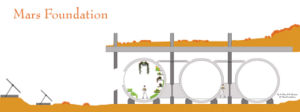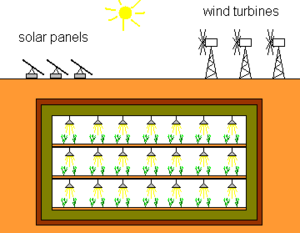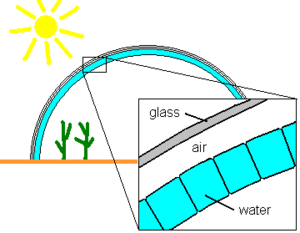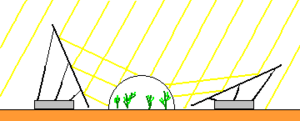Difference between revisions of "Greenhouse"
m (Undo revision 5635 by 184.72.240.48 (Talk) Restoring deletion) |
|||
| Line 35: | Line 35: | ||
Plants can be grown either in liquid fertilizer ([[hydroponics]]) or in [[soil]]. Many plants live in symbiosis with [[microbes]] and [[insects]]. [[Bee]]s can be used to pollinate the blossoms for fruit plants. Probably, the greenhouse is less labor-intensive with as many natural processes as possible, including decay of dead parts of plants to [[compost]]. The growth of flora and fauna under the low Martian [[gravity]] bears some uncertainties. | Plants can be grown either in liquid fertilizer ([[hydroponics]]) or in [[soil]]. Many plants live in symbiosis with [[microbes]] and [[insects]]. [[Bee]]s can be used to pollinate the blossoms for fruit plants. Probably, the greenhouse is less labor-intensive with as many natural processes as possible, including decay of dead parts of plants to [[compost]]. The growth of flora and fauna under the low Martian [[gravity]] bears some uncertainties. | ||
| − | + | I thank you humbly for sharing your wsidom JJWY | |
| − | |||
| − | |||
| − | |||
| − | |||
| − | |||
| − | |||
| − | |||
==Open Issues== | ==Open Issues== | ||
Revision as of 03:55, 6 July 2011

Growing plants in a Greenhouse delivers oxygen and food. It can play an important part in human recreation (Mars Garden) and may be the place for funerals. The sunlight is not bright enough on Mars to allow usual terrestrial plants to thrive, but it provides a valuable part of light energy for plants. Additional energy is necessary for lighting and heating.
The greenhouse will be constructed from transparent material, allowing maximum sunlight to pass, generating an artificial "greenhouse effect". The spectral properties of the material should be optimized to match the absorption characteristics of chlorophyll, maximizing the energy gain.
Plants need a mix of air pressure and temperature. The greenhouse must be strong enough to hold that air pressure, and it must be insulated to hold the temperature inside. Photosynthesis works only at fairly high temperatures.
Contents
Side-lit Greenhouse Concept

The Mars Foundation concept for a greenhouse involves the maximum use of local materials to avoid waste, maximize energy input and optimize space. Spawned from the Hillside settlement design, the greenhouse would most likely be located inside/next to a hill side (possibly in the location of Candor Chasma). Therefore regolith or some other absorbant material could be suspended above the greenhouse to protect occupants and plants from harmful radiation. The source of light would therefore be directed from the side, via an array of adjustable mirrors. A system of vents and ducts would allow warm air to circulate, perhaps even used to heat the main habitat.
Underground Greenhouse Concept
If geothermal energy is not available the heating will consume large amounts of electrical energy. In this case the sum of energy used for lighting and heating must be considered. An underground greenhouse is easier to insulate to hold warmth inside. On the other hand the effort of lighting is higher, since no direct sunlight is used. This concept has some additional advantages: It is meteorite-safe and radiation-safe.
Natural caves and artificial caves can be utilized to build such an underground greenhouse, which requires a preparation with high effort in either case. The maintenance is quite cheep, for the ambient temperatures are steady and the radiation levels are low, so it is a good long term solution. A combination of greenhouse and living space for the settlers is suggested.
Water-shield Greenhouse Concept
Hydrogen does a good job absorbing cosmic radiation. Water contains highly concentrated hydrogen, and hence serves as a good radiation shield. On the other hand it is highly transparent for visible light and UV. The combination of both makes it an interesting material for greenhouse shielding.
Under a strong pressure resistent housing the water is placed in a thick layer. It absorbes the dangerous parts of cosmic radiation and sunlight and passes most of the spectral parts needed by humans and plants. Additionally, it helps to buffer daily temperature variations because of its high specific heat capacity.
The layering could be as follows: The outer layer is a construction of steel and glass, providing enough strength for the difference in atmospheric pressure. It also serves as insulation for temperature differences. Additional sheets of glass or plastics improve the insulation effect. A self-healing puncture protection should be considered. The innermost layer is the water. It can be held by transparent canisters.
Multiplying Sunlight
A solar concentrator is a set of mirrors that can be used to bring more sunlight into the greenhouse than the base area of the greenhouse receives directly from the sun. Three times the amount of Martian sunlight should be enough to serve terrestrial plants. During good weather periods this allows growing vegetables without additional energy.
Flora and fauna
Plants can be grown either in liquid fertilizer (hydroponics) or in soil. Many plants live in symbiosis with microbes and insects. Bees can be used to pollinate the blossoms for fruit plants. Probably, the greenhouse is less labor-intensive with as many natural processes as possible, including decay of dead parts of plants to compost. The growth of flora and fauna under the low Martian gravity bears some uncertainties.
I thank you humbly for sharing your wsidom JJWY
Open Issues
- How long can plants survive without sunlight (e.g. during a dust storm)?
- How many persons are needed to work in the greenhouse to produce enough food for a hundred persons?
- How much energy is required for heating, especially during long lasting dust storms? This question can not be answered without an experimental setup.
- What temperature and air pressure do plants need?
- What air pressure is needed for persons to work in the greenhouse?
- What transparent materials match the absorption characteristics of chlorophyll?
- Do plants need wind? How can it be provided?
- What is known about radiation tolerance of food crop?
External links
| Concepts: | Greenhouse · Settlements · Locations · General |
| Hazards: | Space Weather · Climate · General |
| Technology: | Hi-Tech · Lo-Tech · Energy · Spaceflight science · Communication · General |
| Human Considerations: | Economics · Health · Governance · Trade · Law · Social |









